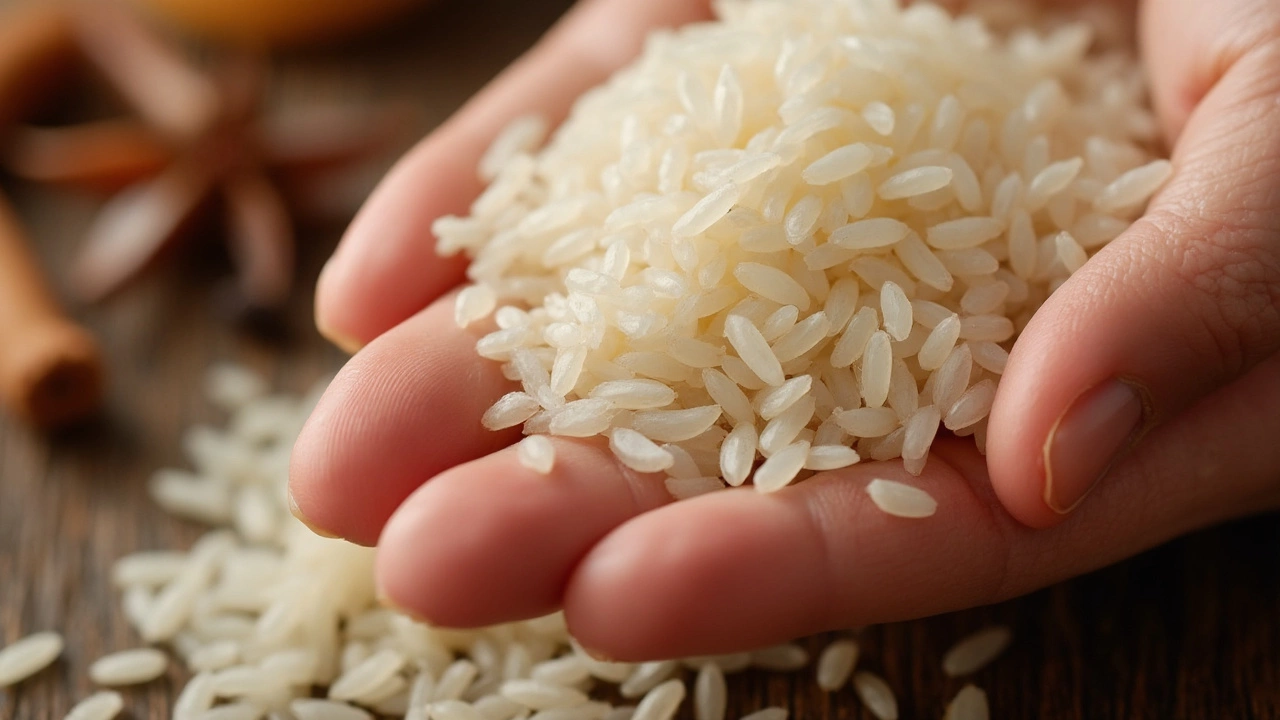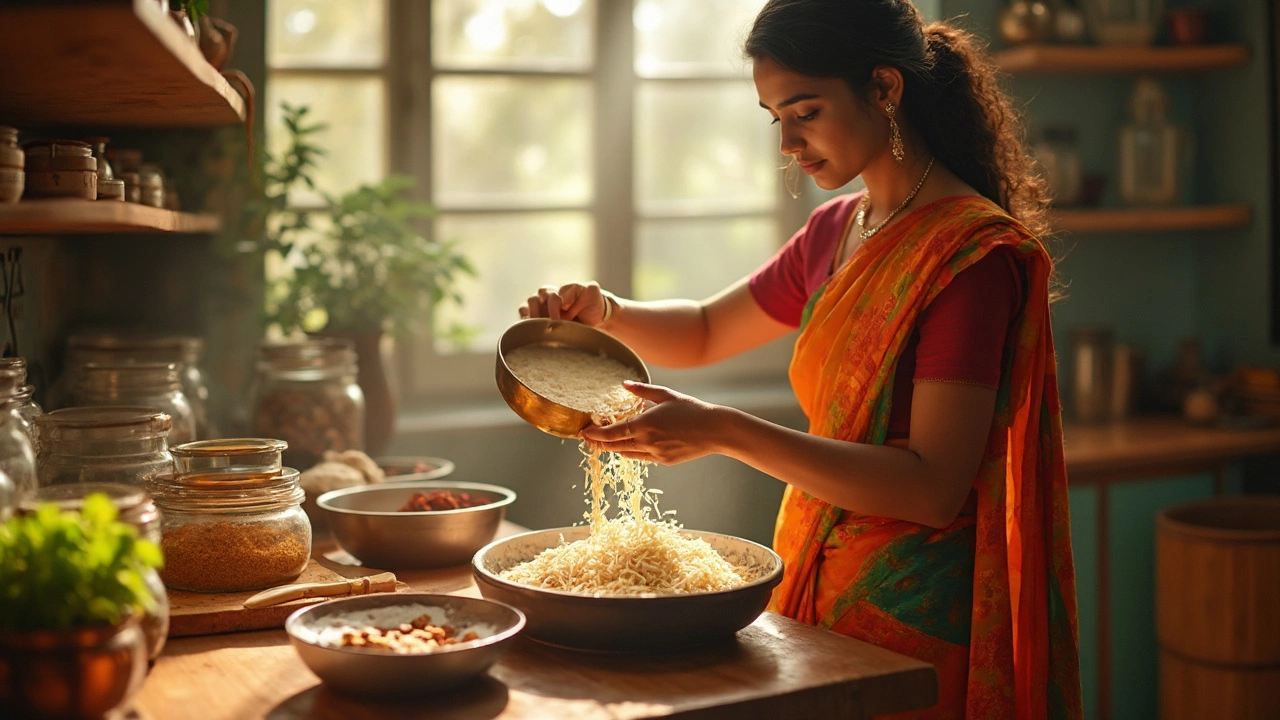Basmati rice is the backbone of any good biryani, but have you ever wondered why chefs fuss about soaking it? That step isn’t just tradition—it’s the secret to grains that stay separate and fluffy. If you skip soaking, you’ll probably end up with sticky rice that clumps together or breaks apart. Nobody wants biryani that turns into a mushy mess.
The sweet spot for soaking basmati rice isn’t guesswork. It’s usually between 20 and 30 minutes. This time lets the grains absorb just enough water to elongate during cooking, but not so much that they split. Some folks have been known to go overboard with hours of soaking, but honestly, you won’t get better results after the 30-minute mark—and sometimes things actually get worse. If you’ve only got a few minutes, a quick 10-minute soak is better than nothing, but you might have to tweak your water ratio a bit.
- Why Basmati Rice Needs Soaking
- How Long to Soak: The Sweet Spot
- What Happens If You Skip Soaking?
- Handy Tips and Tricks for Busy Days
Why Basmati Rice Needs Soaking
Soaking basmati rice before cooking isn’t just a random step; there’s science behind it. The long grains of basmati have starch on the surface, which tends to make rice sticky if you cook them straight from dry. A soak helps that extra starch get released when you rinse, so your grains won't clump together in the pot.
When you soak basmati, the grains absorb water and start relaxing. This means they need less cooking time later, which helps keep the grains intact and makes them longer and fluffier. In Indian households and restaurants, soaking is a common hack to get that signature fluffy biryani rice, instead of a gluey mess.
For biryani, texture matters. You want rice that's separate and light, not stuck in lumps. Skipping the soak usually leads to broken, short grains, especially during the boiling phase. Plus, soaking helps rice cook more evenly because each piece has soaked up some water already.
| Soaking Time | Expected Rice Texture |
|---|---|
| None | Sticky, clumpy |
| 10 minutes | Better, but some grains may break |
| 20-30 minutes | Long, separate, fluffy |
| Over 45 minutes | Can get mushy, weak grains |
One more little-known fact: soaking can cut cooking time by about 20%. In kitchens where time = flavor (like restaurants and at home on busy nights), that makes a big difference.
If you really want the best out of your soak basmati rice experiment, always rinse the rice well before and after soaking. This double rinse ditches the cloudy water and the last bits of loose starch, setting you up for perfect biryani later.
How Long to Soak: The Sweet Spot
If you want the perfect biryani, timing your rice soak is seriously important. For soak basmati rice, the magic number usually lands between 20 and 30 minutes. That’s not just a grandma’s tale—it’s what you’ll find chefs and home cooks agreeing on across South Asia. Go under 20 minutes, and your rice might not hydrate enough, so it won’t elongate right. Go much over 30, and it could start getting soft and breaking, especially if your rice is on the older side.
Here’s a breakdown to clear up the confusion:
| Soaking Time (minutes) | Result After Cooking |
|---|---|
| 0-10 | Short grains, may be uneven or break; needs careful water adjustment |
| 20-30 | Long, fluffy, separated grains—this is ideal |
| 60+ | Risk of mushy or broken grains—can spoil texture |
One thing that often gets missed: rinsing is not the same as soaking. Always rinse your basmati rice first to wash away extra starch—it usually takes about three changes of water until it runs clear. Then, soak in fresh water at room temperature. For 1 cup of dry rice, use enough water to cover by at least an inch.
If you’re in a rush, say you’ve got hungry guests already sniffing around, you can cheat with hot water and soak for just 10-15 minutes, but then cook with a little less water in the pot. It’s a quick fix—not perfect, but a whole lot better than no soak at all.
- If your rice is very old (labeled “aged basmati”), stick to the 25–30 minute window—it will give you the best, longest grains.
- Newer rice needs a bit less, about 15–20 minutes, or it can get sticky.
Biryani kitchens don’t mess around with this step, and neither should you if you’re after that restaurant-style texture. Sync up your soaking time with your biryani prep, and you’ll never stress over clumpy rice again.

What Happens If You Skip Soaking?
Skip soaking, and you’re rolling the dice with texture. When you cook basmati rice straight out of the bag, the grains don’t have a chance to gradually absorb water. Instead, they suck up hot water fast, which can cause them to swell unevenly and break apart. You end up with rice that’s either sticky or broken—definitely not that classic, lengthened biryani look people chase after.
If you care about each grain staying long and fluffy, soaking is your secret weapon. When you don’t soak, your rice may turn out clumpy because surface starches don’t get rinsed off properly. That extra starch hangs around and acts like glue in the pot. Even for seasoned home cooks, it’s harder to get perfect rice without that soak.
Here’s a quick side-by-side so you can see what you miss out on:
| Soaked Basmati Rice | Unsoaked Basmati Rice | |
|---|---|---|
| Rice length after cooking | Up to 2x original length | No noticeable elongation |
| Texture | Fluffy, separate grains | Clumpy, may break or stick |
| Cooking consistency | Even | Some grains overcooked, some undercooked |
If you accidentally forgot to soak, here are a couple of ways to make things a bit better:
- Rinse your rice really well—at least 3-4 times—until the water runs clear. This helps remove surface starch.
- Add a splash more water than you usually would. Unsoaked rice needs a bit of extra liquid to cook through.
- Keep an eye on cooking time; it might take a few minutes longer than normal.
But if you want that classic, restaurant-style biryani with every grain showing off, soaking basmati rice is non-negotiable.
Handy Tips and Tricks for Busy Days
Life gets hectic—sometimes there’s just no time to soak basmati rice the “perfect” way for biryani. But you don’t have to compromise on rice texture. If you’re rushing, you’ve got options. Here are smart shortcuts and common-sense workarounds that actually work in your everyday kitchen.
- Quick hot water soak: If 20-30 minutes isn’t in the cards, use hot water instead of cold. Soak the rice for about 10 minutes; the heat speeds things up so grains puff up faster.
- Rinse really well: If you completely skip soaking, at least rinse your basmati rice three to five times under cold running water. This removes a lot of the surface starch that causes clumping.
- Add a teaspoon of lemon juice: In emergency situations, add a teaspoon of lemon juice while boiling the rice. This old home trick helps keep the grains separate.
- Reduce water a touch: If you didn’t soak, use slightly less water during cooking—about 1.5 cups water for every cup of rice, rather than 2 cups—so the rice doesn’t get soggy.
- Microwave hack: No time at all? Some people spread rinsed basmati on a plate, microwave on high for 45 seconds, then cook as usual. It’s not traditional, but it can open up the grains fast.
Let’s compare how skipping or adjusting soaking impacts cooking. Here’s a quick table so you can adjust on the fly:
| Soaking Time | Suggested Water Ratio | Cooking Texture | Estimated Time Saved |
|---|---|---|---|
| None (rinsed only) | 1.5 cups water per 1 cup rice | Softer, might stick a bit | ~30 min |
| 10 min (hot water) | 1.75 cups water per 1 cup rice | Fairly fluffy, slightly firm | ~15 min |
| 20-30 min (cold water) | 2 cups water per 1 cup rice | Longest, most fragrant grains | 0 min (normal recipe) |
Bottom line: even if you’re short on time, you can still get great results. Just remember, the main goal is to keep those grains long, fluffy, and as separate as possible for the best biryani.
